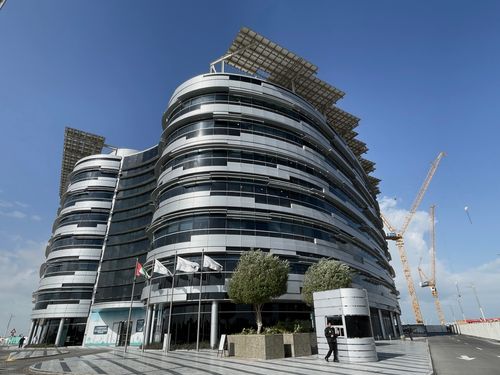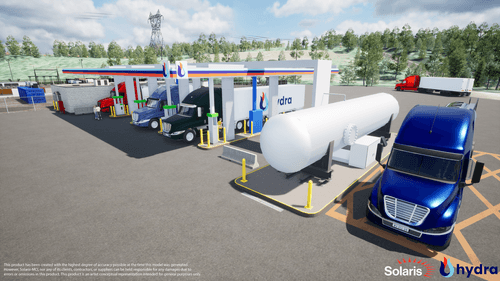Canadian hydrogen-as-a-Service developer Hydra Energy has achieved another significant milestone in its Prince George, British Columbia project rollout by signing detailed MOUs with eight new commercial truck fleets in the region.
This represents 82 Class 8 trucks to be retrofitted using Hydra’s proprietary hydrogen-diesel, co-combustion conversion technology, according to a news release.
Once converted by Hydra installation partner, First Truck Centre, these trucks will refuel at the world’s largest hydrogen refuelling station Hydra is currently building in Prince George to be operational in 2024 which leverages green hydrogen produced on site by two 5 MW electrolysers powered with hydroelectricity.
These new fleet commitments and supporting hydrogen infrastructure from Hydra will make this the largest commercial deployment of hydrogen-diesel co-combustion transportation vehicles in the world as Hydra continues to fast track emissions reductions in the hard-to-abate trucking sector.
Hydra continues to work on the closing of a CAD 14m equity capital raise with several parties interested, with proceeds supporting the development of the Prince George project, a Hydra spokesperson said in response to inquiries.
The equity portion of the financing is needed to unlock an additional CAD 150m debt facility to complete initial scale-up of the company’s planned hydrogen corridor along Highway 16 in Western Canada, Hydra Energy CEO Jessica Verhagen told ReSource last year.
“Upon signing our first commercial fleet customer in Prince George and breaking ground on our local refuelling station last year, we had an initial goal to secure 65 heavy-duty trucks to leverage the new station once operational next year. We’re pleased to surpass this target with the signing of these eight fleets highlighting the continued interest in hydrogen trucking and the benefits it delivers for fleets of all sizes, even with heavy payloads in challenging weather and road conditions like those found in Northern B.C.,” Verhagen said in today’s release. “Securing immediate offtakers for our station’s low-carbon hydrogen is another critical piece in our Prince George HaaS blueprint illustrating to potential investors and licensees how hydrogen supply and demand can profitably come together. We look forward to working with First Truck Centre to start converting these trucks about six months prior to our station’s opening and to continuing to work with the City of Prince George as the flagship stop in the Western Canadian Hydrogen Corridor we’re building between the B.C. Coast and Edmonton.”
The eight companies who have signed MOUs represent a range of fleet sizes and types of heavy-duty trucks highlighting the cost effectiveness of Hydra’s HaaS business model and the platform agnostic nature of the company’s dual-fuel conversion technology. For example, Arrow Transportation Systems is a leader in bulk commodity hauling, reload operations, and freight management serving North America and according to Jacob Adams, their Manager of Optimization and Sustainability, “is excited about the potential opportunity to collaborate with Hydra on hydrogen-converted trucks.”
Added Annie Horning, CEO of Excel Transportation, a Prince George-based transport and logistic service company for the forestry industry who also signed an MOU, “Once we heard about the progress Hydra has been making on their hydrogen refuelling station right in our own backyard, the fact their hydrogen wouldn’t cost us more than diesel, and that it would cost nothing to retrofit our trucks to run cleaner and more efficiently, we couldn’t pass on the opportunity. Hydra allows us to make a positive difference sooner than later while eliminating our range anxiety concerns that could impact our service reliability.”
Hydra’s Service Delivery Lead, Ilya Radetski, elaborated, “In addition to Arrow and Excel, we also signed MOUs with Edgewater Holdings, Wilson Bros. Enterprises, Burke Purdon Enterprises, Godsoe Contracting, Keis Trucking, and Peace Valley Industries who all service the Prince George and Northern B.C. region. We also continue to have ongoing discussions with additional local fleets who are keen to explore how hydrogen can benefit them. These contracted offtakers now complete the final piece of our initial HaaS regional model which, as mentioned, also includes an installation partner, hydrogen production, and then the hydrogen refuelling station. This forms an easily reproducible template for licensing companies along the hydrogen value chain who want to see their hydrogen supply or infrastructure come to market at scale in the most profitable way possible, in Canada and beyond.”
“Hydra is an example of a company that tailors their solution to this region instead of using a one-size-fits-all approach. Their technology can work in the cold and doesn’t affect payload or power. We continue to watch their exciting progress locally and support their efforts in helping Prince George diversify its economy and improve air quality,” added Prince George Mayor, Simon Yu.







